Continuing my epic trip from Cape Town to Namibia, the second part of my journey took me into Namibia where I visited the Fish River Canyon and Namib Desert. These two attractions are some of Namibia’s most stunning and fantastic. Fish River Canyon is one of the largest canyons in the world with expansive views throughout the plain.
Aside from the Skeleton Coast, the Namib desert is perhaps what Namibia is most known for. Large, expansive dunes that look like they’re kissed by fire cover the landscape. Sossusvlei, along with Deadvlei, are perhaps the most picturesque places in the world.
Crossing Borders and Fish River Canyon
After finishing up our canoeing excursion at the Orange River, we head to the Namibia border right down the road. While the border crossing from Kenya to Tanzania could be best described as disorganized chaos, the Namibian-South African border is a proper border crossing. With nice paved roads, orderly queues, and clean facilities, you can really see the difference between Southern Africa and Eastern Africa. We were in and out of this place within half hour.
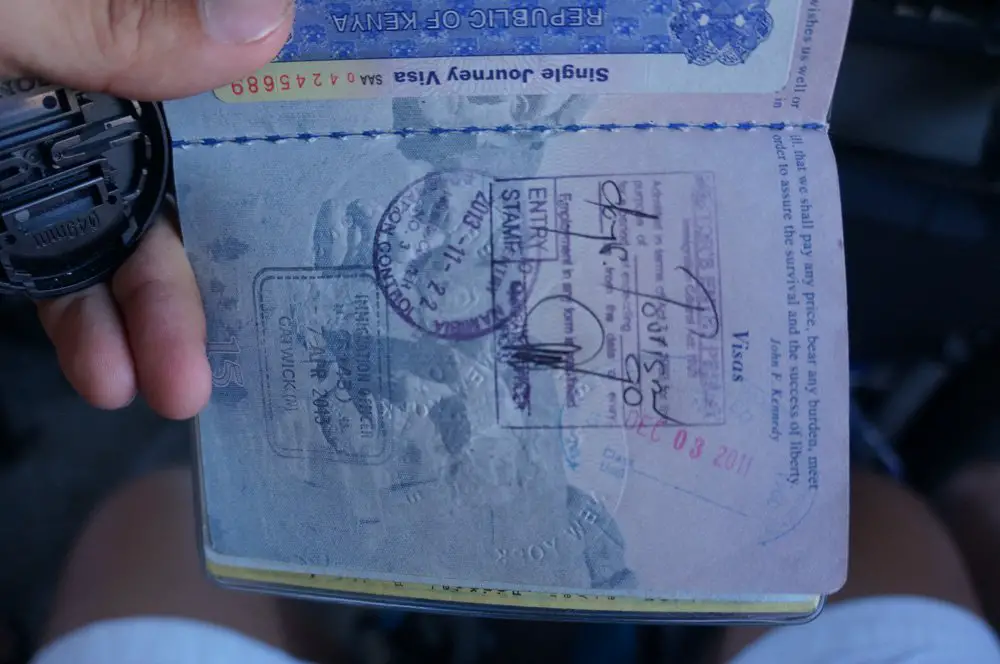
Namibia does not require a visa and is one of the few tourist driven countries in Africa along (Botswana the other) that does not require you to purchase a visa if you’re American/Canadian/EU/AUD etc. The Namibian currency is also pegged 1-1 with the Rand, meaning 1 Namibian dollar will always equal 1 Rand. The South African Rand is accepted throughout the country so there’s no need to change your rands. However, Namibian dollars are not accepted in South Africa.
Country Facts – Namibia (in $USD) |

| Capital | Windhoek | |
|---|---|---|
| Population | 2.5 million | |
| Official Language(s) | English | |
| Currency | Namibian Dollar | |
| Visa | Not Required for US/EU/AUS | |
| GDP Per Capita | $5,700 | |
| Power Plug Type | South African | |
| Cars Drive On | Left | |
| Time Zone | GMT + 2 |
Fish River Canyon
After a few hours of driving through the ever changing Namibian landscapes, we finally arrive at our camp of the night at a place called Hobas. When I originally read through the itinerary, I didn’t know anything about the Fish River Canyon, and thought it was in fact just a river (didn’t think about the canyon). In fact, the Fish River Canyon of Namibia is one of the must sees of the country and is the second largest canyon in the world after the Grand Canyon in America! It’s about 160km long, 27km wide, and about 600m deep.
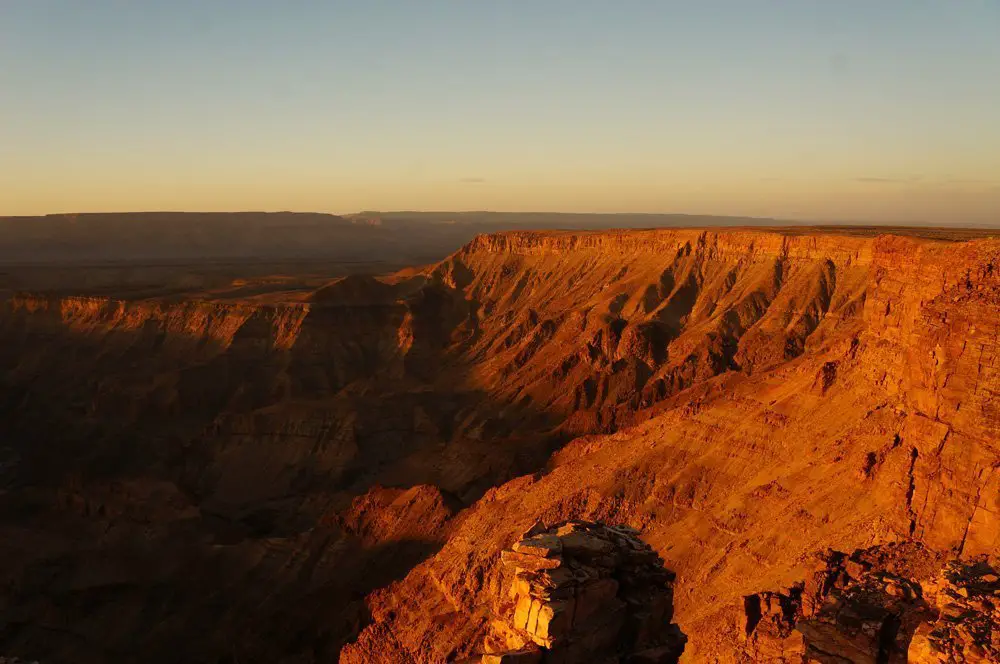
After setting up the tents for the night, we drive towards a viewing point to do some hiking along the canyon and to enjoy the sunset. For anyone that has visited the Grand Canyon, you’ll have a good idea of what to expect but if you haven’t, this place is incredible. It was a very welcome surprise to me as I had no idea this was coming. The hiking is not difficult but make sure to wear some proper shoes (unlike myself who forgot to pack proper shoes). Absolutely make sure to come during sunset as the colors of the sunset contrasted with the rocks really make for some amazing visuals and pictures.
We hang out here for about two hours giving us plenty of time to soak it in and we leave after the sun has set. There’s not much words can do to describe this place. In fact, not much words can do to describe a lot of the places I went to in Namibia so pictures will have to suffice.




We return back to the camp for dinner and yet another early night as wake up call the next day is brutally early. The bar closes here early so make sure to buy beers before leaving for the Canyon if you want any entertainment for later in the night. There’s nothing to do at this camp.
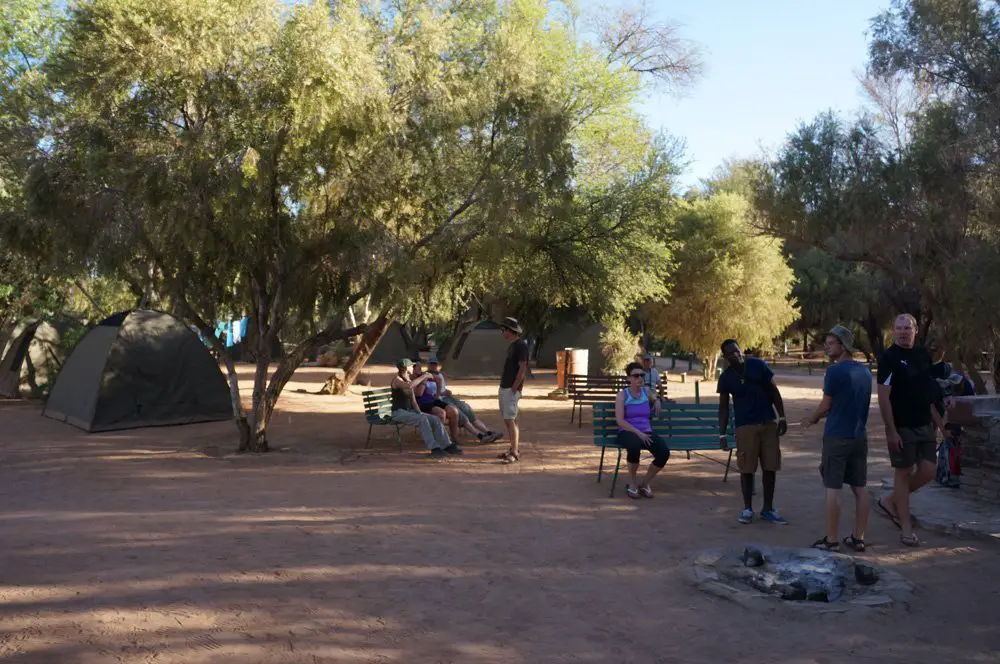
One fact to know about Namibia is that it has some of the cleanest air in the world. Because of this, there are less particles in the air to obstruct your views of the stars. It never got old to just look up at night time and seeing thousands of stars around you. Nevertheless, there will be better places to stargaze later in the trip.
The Namib Desert
As we pack up our tents from the Fish River Canyon stop, we continue our drive north deep into the Namib Desert. The drive again takes most of the day with still changing landscapes. All vegetation has now vanished from the mountains and the sandy dunes are not far away.
Biltong in Namibia
Biltong is akin to Beef Jerky but in my opinion a hundred times tastier. It’s a staple snack in South Africa but because of the large Afrikaner population in Namibia, along with the huge amount of beef the country produces, it is also eaten here. There are many stops along the way where I loaded up on this delicious snack because snacking is something I constantly did as it gets boring sitting in the truck. Biltong and Chili Sticks, all you need to have a good road trip.
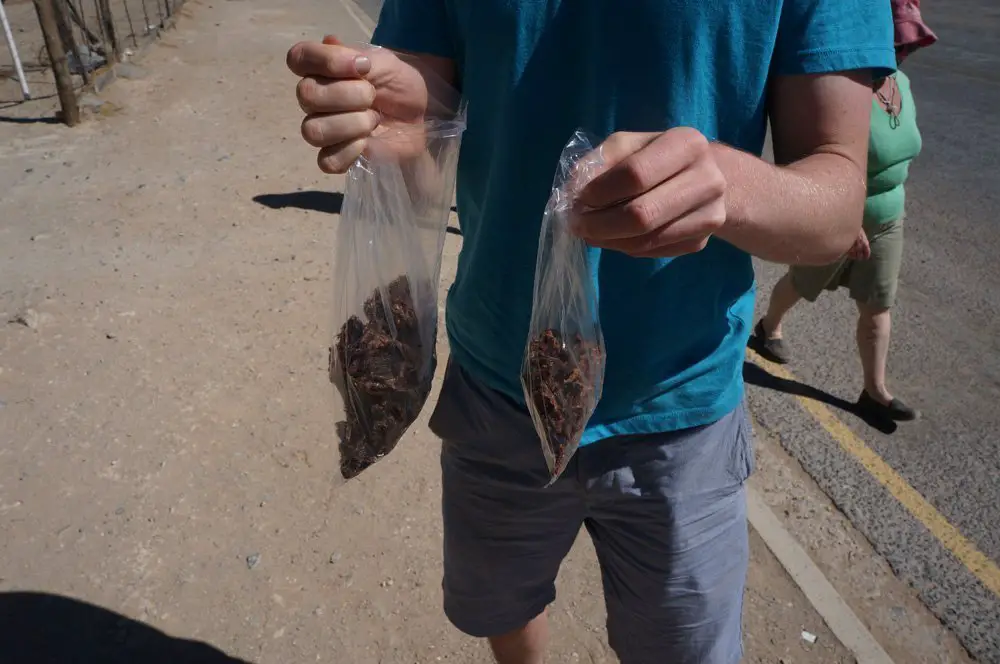
Sesriem Camp in the Namib Desert
Power Plugs: Yes | Hot Showers: Yes | Wifi: No | Toilets: Yes
We eventually reach our campsite for the night at a place called Sesriem. It’s right on the edge of the desert. One side you can start seeing the magnificent dunes, and the other are rocky mountains. This is as close as you can get to Sossusvlei but it is still another 60km away. This area of the Namib desert with the sandy dunes is actually called the Namib-Naukluft park, and is an official government sponsored park with official opening and closing hours. Sossusvlei is actually just one little area within this greater park. The campsite is huge as it is the main camp people will stay at before they visit the park.
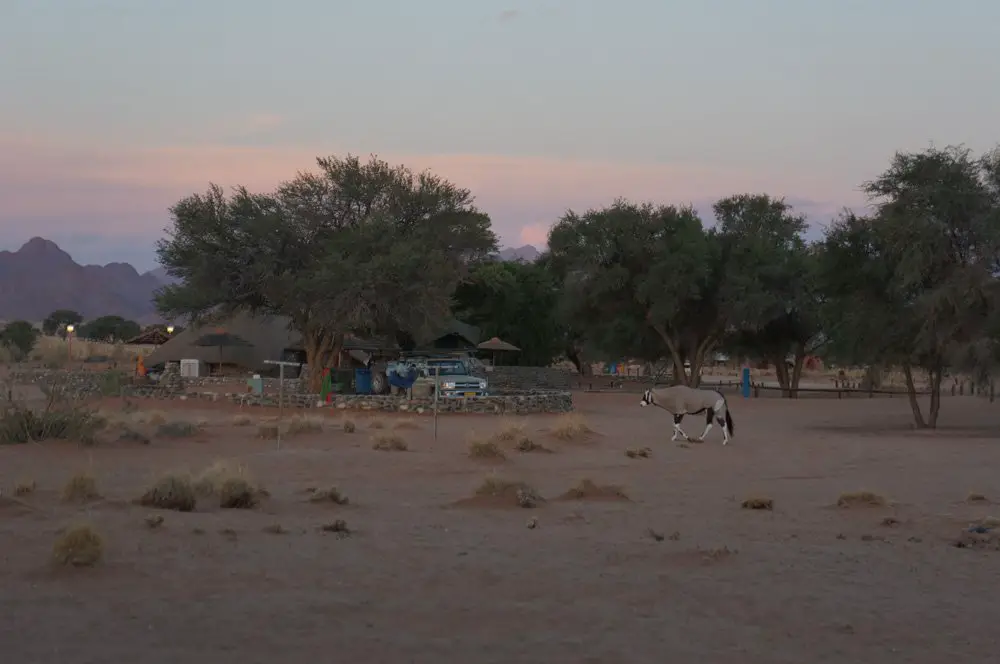
Sesriem Canyon excursion
Nearby the camp is yet another canyon. This canyon is nothing like the Fish River Canyon we saw the previous day, so visiting this place was actually anti-climactic. Nevertheless, it was small enough where you could actually walk down into it. There isn’t much to do here besides just walk down and take a few pictures. It does give you something to do in your heightened anticipation for next morning’s activities.
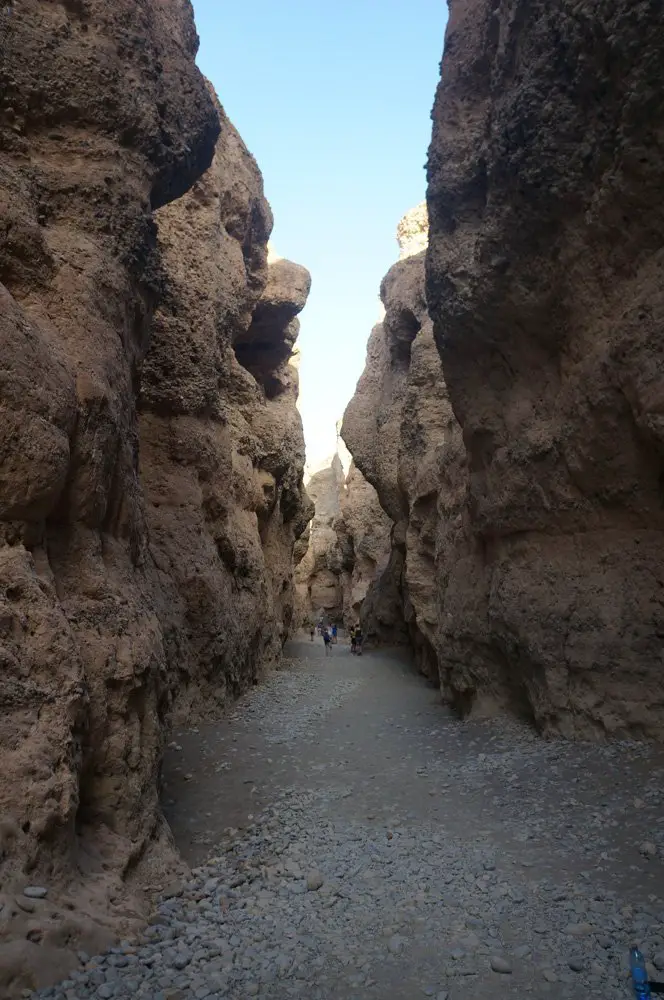
Wake up call is at 4am the next morning as we wanted to be out of the camp by 5am so we could reach the dunes in time to climb up and watch the sunrise.
Namib-Naukluft Park
We have absolutely no problem waking up the next day as everyone is extremely excited. This is without a doubt, the highlight of the trip for me. I had seen so many pictures of this place before I went on this trip and had been looking forward to it since I moved to South Africa. Time is finally here!
Our destination within the park was to a dune named Dune 45. It’s named such as it is the dune that is 45km from the Sesriem camp’s main gate and Sossusvlei. It’s the most commonly climbed dune in this park because it’s close to the road and is frequented by the overland groups.
Scaling the dunes at sunrise
As we depart the truck at the base of Dune45, it was still dark out and the sun was just inching up over the horizon. There was another overland group that came here early like us and we all begin the trek to the top. Word to the wise, climbing a dune is not easy.
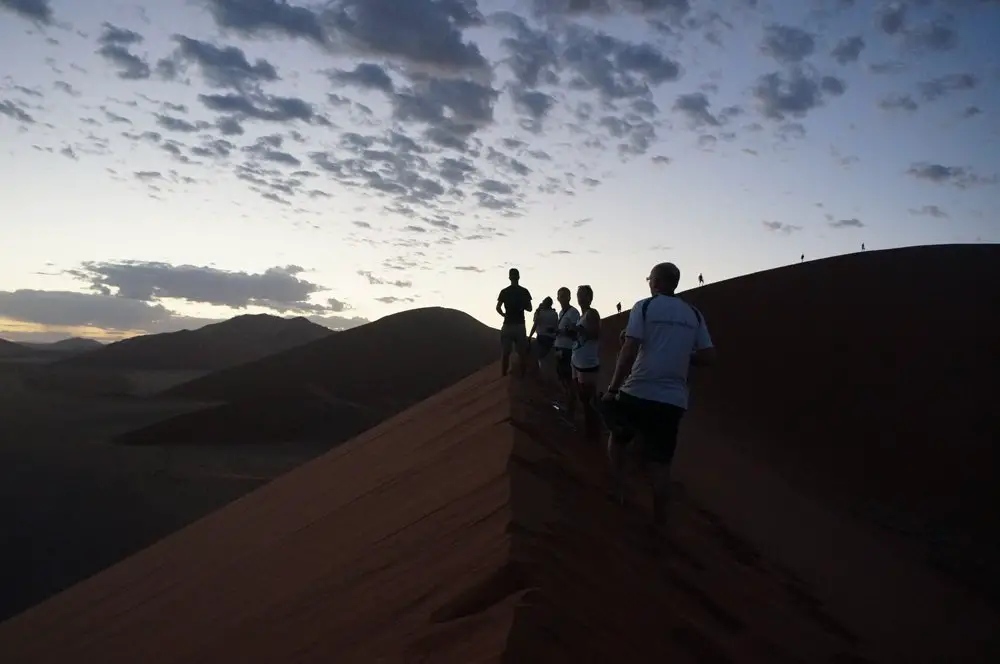
Dune45 is only about 170m tall, and looking at these amazing works of nature from afar, I thought climbing would be a piece of cake. Very wrong. When you climb up these things, the sand is so soft that your feet will sink deep into the sand so when you take that next step, your legs are bent so you are more or less doing a lunge while climbing up a mountain. Anyone with weak knees, I wouldn’t recommend this climb.
The trick is to not wear shoes (which is why you must go in the morning before the sand becomes too hot) and not be the trail blazer. Let other people go ahead of you, and have them pave a trail for you to climb. As more people step into the sand, it flattens out and you may no longer sink into the sand since a bunch of people took care of that for you, and thereby reducing the lunging you do.
When you’re finally there, and when the sun rises, wow this place is surreal! The perfectly shaped, flaming orange dunes stretch as far as the eyes can see. It took me a half hour to reach the top but this is just the first dune among so many. You’re tired by this point and have little desire to keep exploring. Really makes you wish you could fly so you can explore deeper into the desert. Nevertheless, we got a good spot and watching the sunrise perched on top of the dune is nirvana.
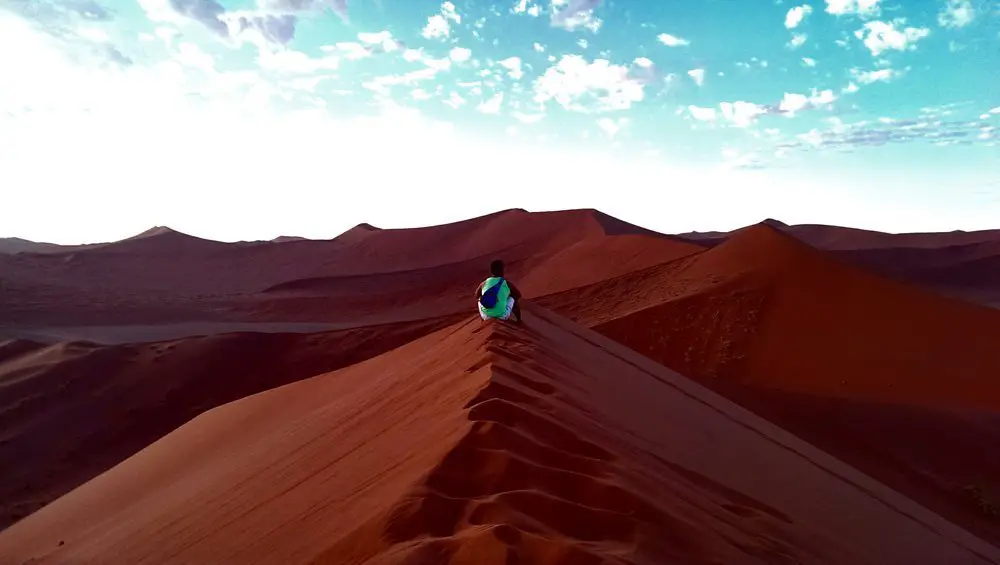

This will probably be the coolest thing you see on the trip (for me it was at least), so make sure to take a thousand pictures as who knows when you’ll return? Be prepared to have sand in your shoes and shorts for days. Small price to pay for the experience.
Sossusvlei and Deadvlei
After an hour hanging out on the dunes, we ran down (highly recommended), and could see that more people were headed to Dune45 in droves. We were glad we made the effort to wake up early so we could have the dunes to ourselves. After having breakfast next to the dune, we take a 4×4 deeper into the park where it dropped us off within walking distance to Sossusvlei and Deadvlei.
Sossusvlei is actually an area within the park that consists of clay and salt pan, surrounded by high red dunes. A pan is a lake that has completely dried by through the ages and the remnants are something akin to soft and flat rock. Sossus means “Dead End” in the local language, and vlei is Afrikaans for “Marsh” so combined together means dead end marsh. By this time, it was around 9am and the sun was already starting to beat down hard. The sand was still walkable but quickly heating up. I’d recommend a few minutes in Sossusvlei just to see it but the real prize is at Deadvlei.

Deadvlei
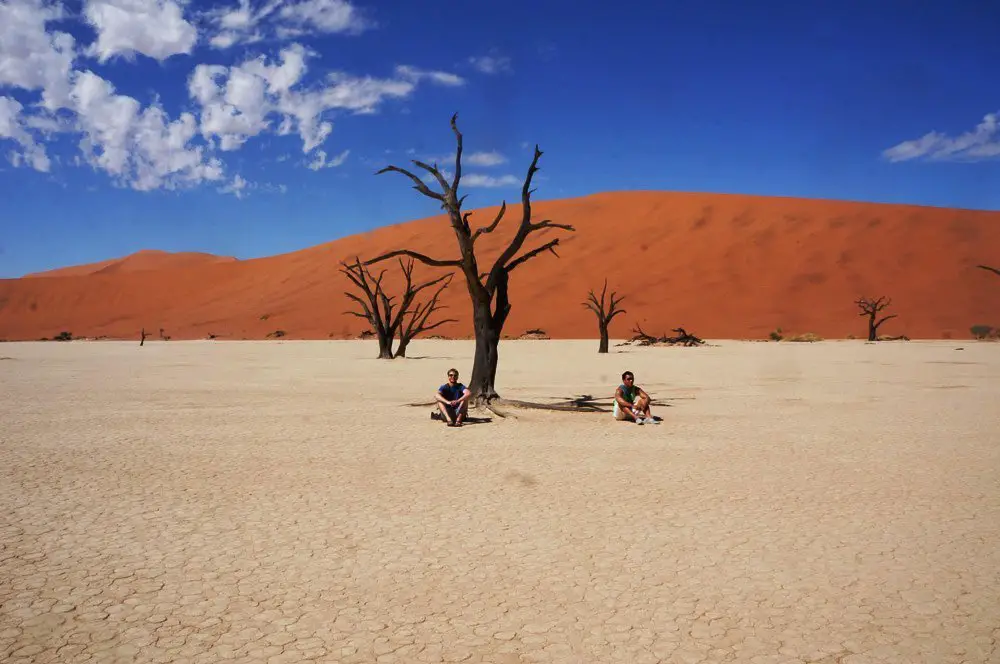
Deadvlei is an area within the desert that used to have water and trees but over the years, the water dried and all the trees died. However, the trees’ skeleton remains and it’s situated on a pan, surrounded by the highest dunes within the park (Big Daddy is the highest dune around 350m). You really feel like you’re on another planet. There are some plants that survive out in the desert, along with animals that have grown accustomed to living off very little water as it rarely rains here. Make sure to take plenty of pictures here as it’s something special.
After seeing the Big Daddy dune in the background, I really wish we had climbed this dune instead of Dune45. It’s the highest dune in the entire park and you can see ALL the dunes as you are at the highest point within the desert. By the time we arrived at Deadvlei, it was far too hot to climb more dunes sadly (40+ C). Oh well, until next time.
Update (Mar 8, 2015) – Sahara Desert vs Sossusvlei
I’ve visited all throughout the Sahara desert on my recent trip to Tunisia, Jordan, and Egypt and I think the Namib Desert in Namibia is far more stunning of a destination.
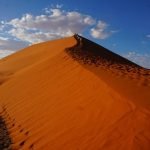
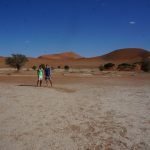
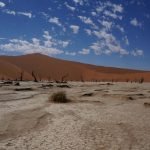
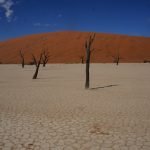

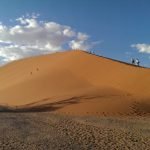
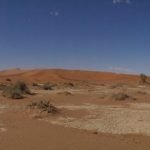

Bushman Tour
After our amazing experience in the Namib desert, we depart Sossusvlei before noon and make a quick drive to our next campsite. The dunes disappear quickly from sight and the scenery shifts from a mix of dunes and mountains. If you come to Namibia in the November time period, the wet season will just be starting and if you are lucky enough to see the rain clouds, the contrast with the desert scenery is something special.
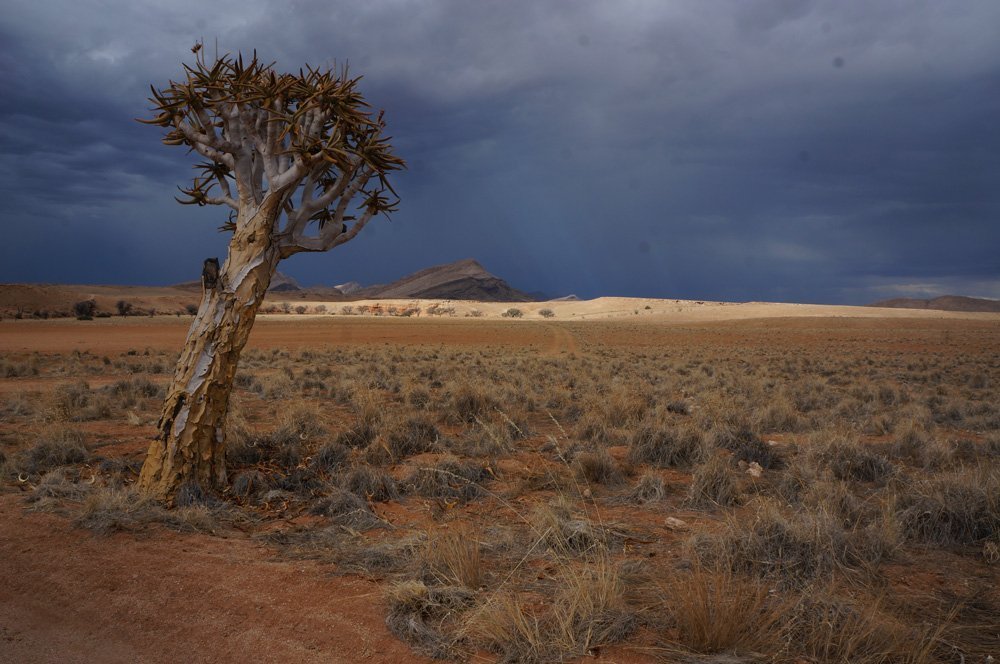
I was confused why we wouldn’t just drive to Swakopmund from here as it is only a 3 hour drive but the itinerary had this Bushman tour slated into our schedule. I was ready to get back to civilization and to a proper city but this bushman tour was amazing. I am 100% glad we stopped to do this. Like the Bushmen tour we did in South Africa, the San culture is different in this part of the world as the terrain is so dry and water is so rare.
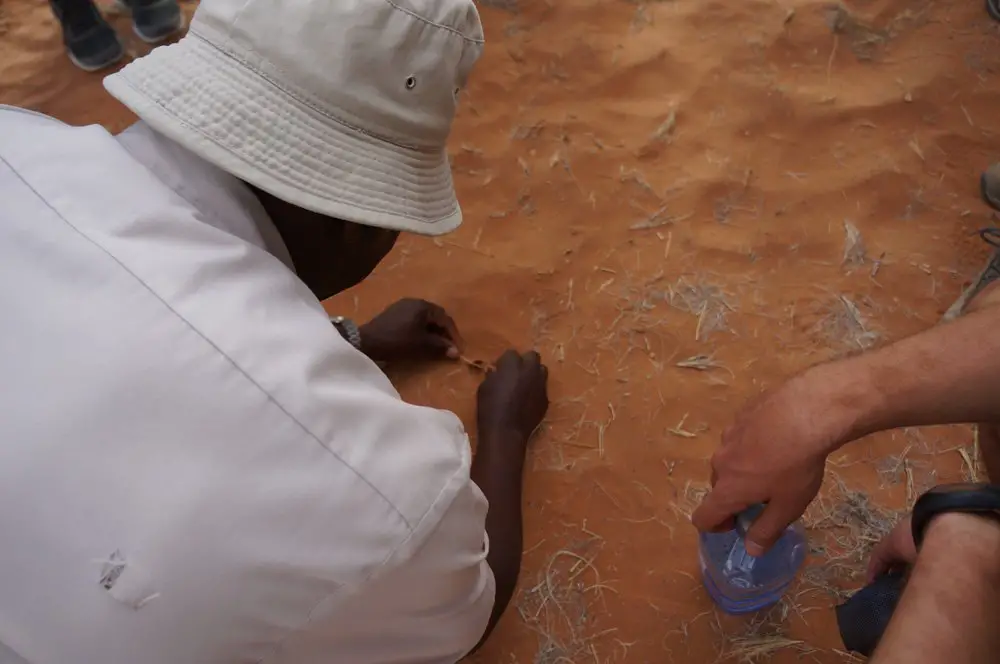
Our guide, Franz, grew up in a new world Bushmen society because again, the old nomadic lifestyle is only practiced within a few areas of Botswana. Franz drove us around the desert terrain, telling us about his childhood, how they hunt, the different types of vegetation, what to do when you run into a hyena, how to react when a scorpion is on your foot, etc. This guy was straight bad-ass.
The Bushmen culture of Namibia is as nomadic as it gets. In fact, it makes other Nomadic cultures around the world seem like they live in a big city. When they used to make a kill, instead of bringing the animal back to the village, they uprooted the entire family and moved them to where the kill was made to eat.
If there were individuals unfit to travel, they would be left behind and if they died, then they died. Wow. That’s the way of life however, when temperatures regularly reach 45 degrees, water is scarce, and rain comes once or twice a year, only the strong can survive.
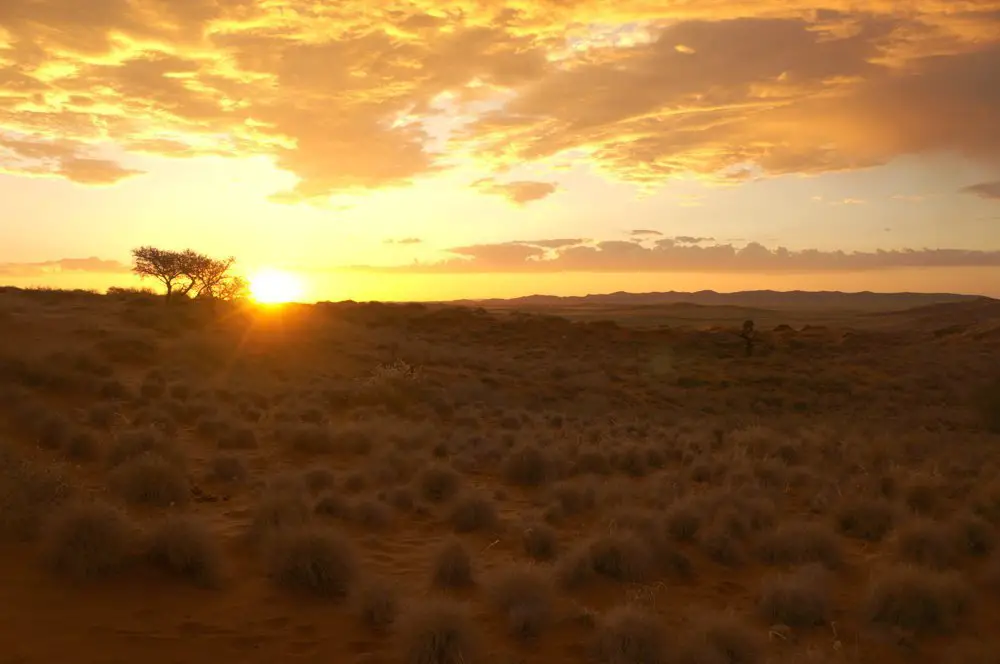
Once the tour concludes at sunset, I really felt like I learned a lot about their culture. Dinner is served back at the camp, and wake up call is early yet again so we head to bed and prepare to return to society tomorrow.



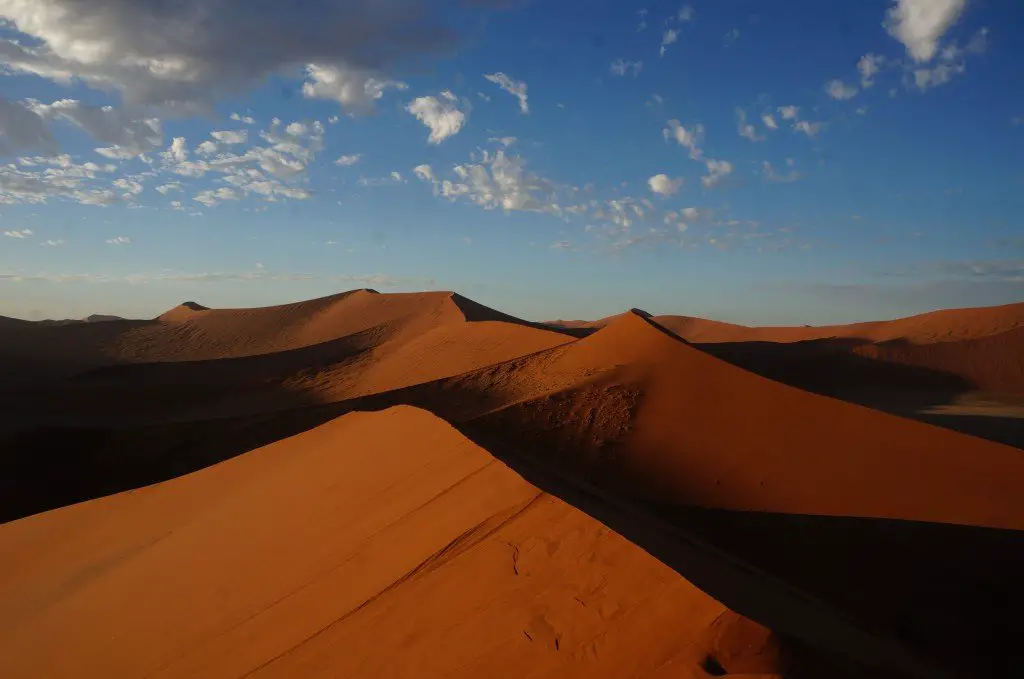

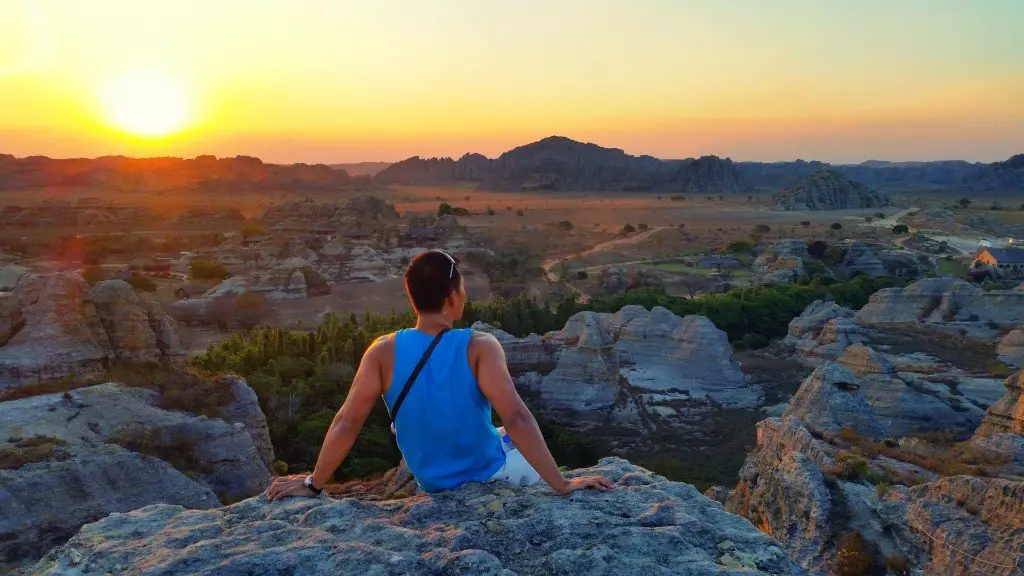

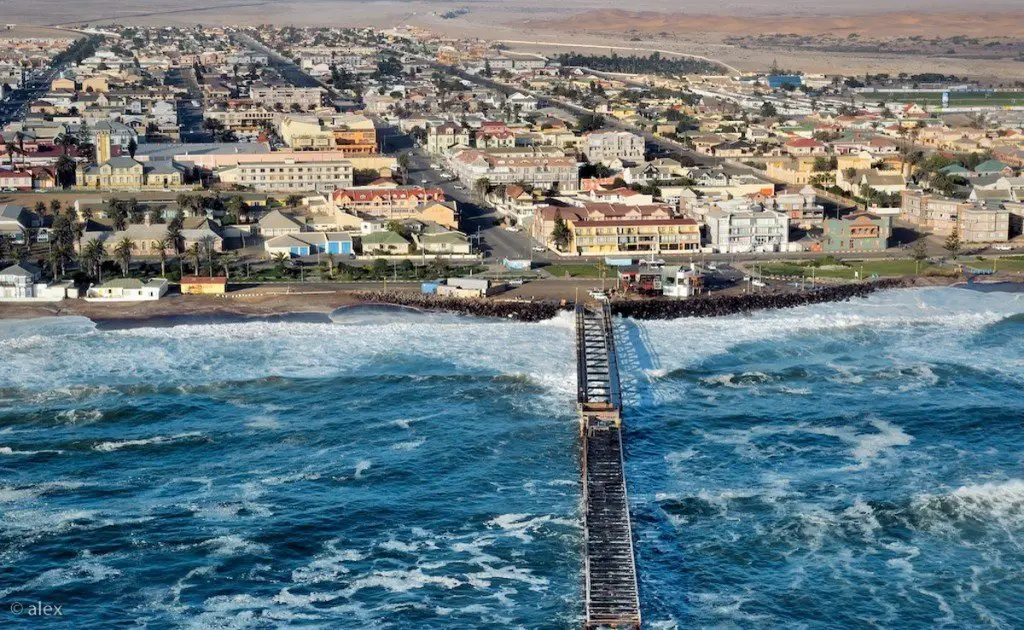


Unreal!